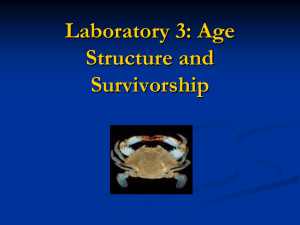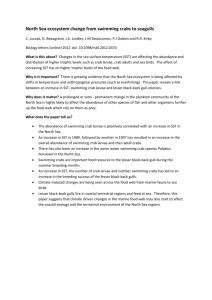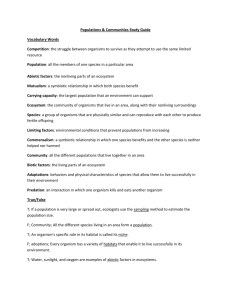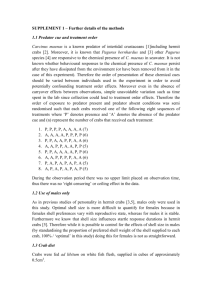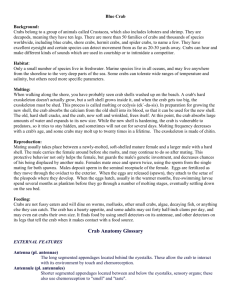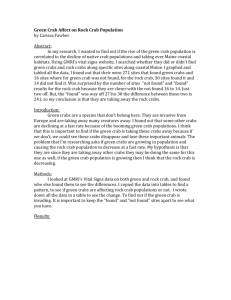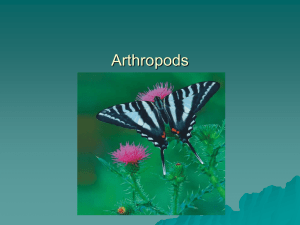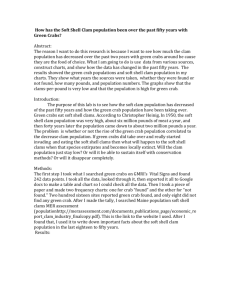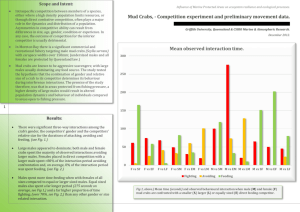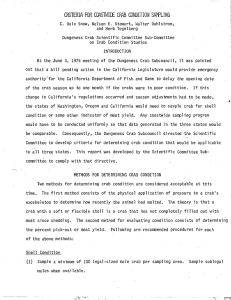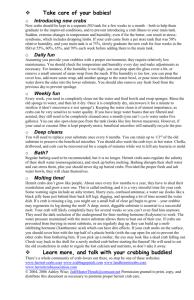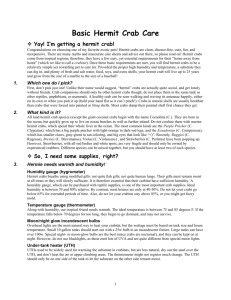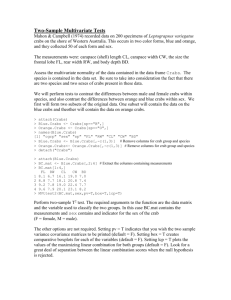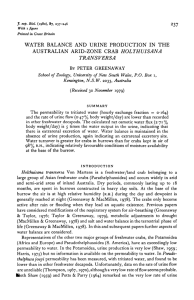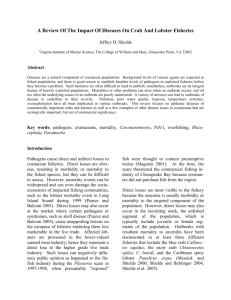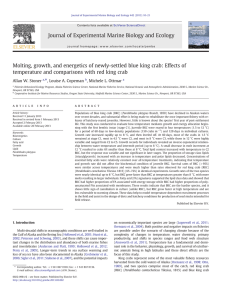Blue Crab - CFCC.edu
advertisement
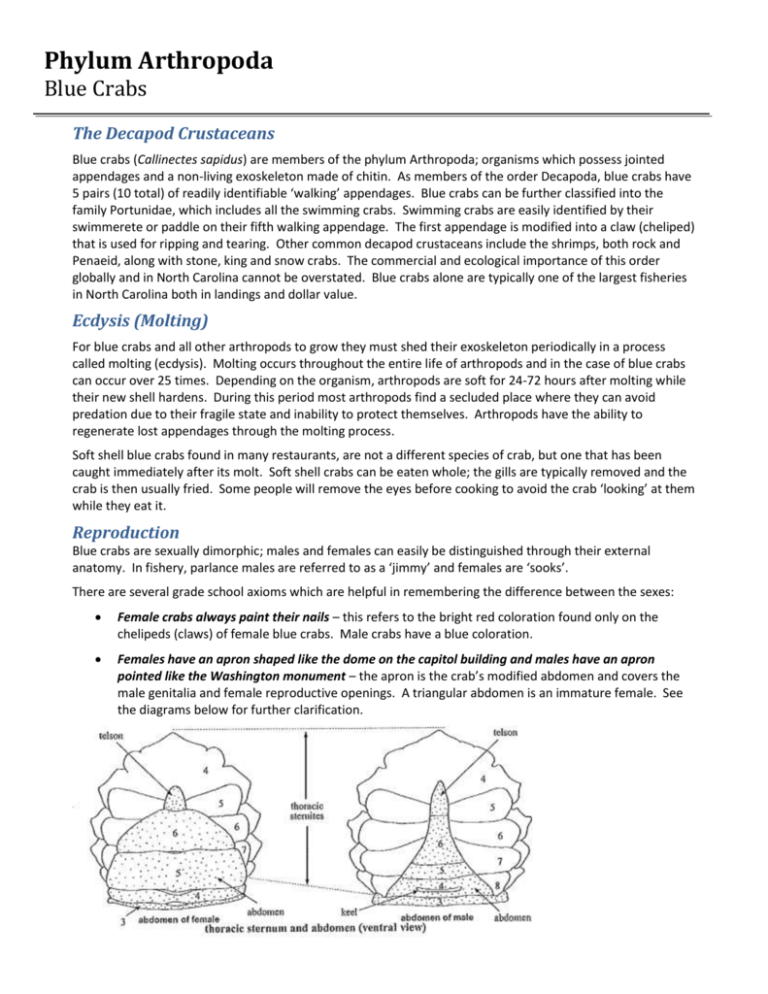
Phylum Arthropoda Blue Crabs The Decapod Crustaceans Blue crabs (Callinectes sapidus) are members of the phylum Arthropoda; organisms which possess jointed appendages and a non-living exoskeleton made of chitin. As members of the order Decapoda, blue crabs have 5 pairs (10 total) of readily identifiable ‘walking’ appendages. Blue crabs can be further classified into the family Portunidae, which includes all the swimming crabs. Swimming crabs are easily identified by their swimmerete or paddle on their fifth walking appendage. The first appendage is modified into a claw (cheliped) that is used for ripping and tearing. Other common decapod crustaceans include the shrimps, both rock and Penaeid, along with stone, king and snow crabs. The commercial and ecological importance of this order globally and in North Carolina cannot be overstated. Blue crabs alone are typically one of the largest fisheries in North Carolina both in landings and dollar value. Ecdysis (Molting) For blue crabs and all other arthropods to grow they must shed their exoskeleton periodically in a process called molting (ecdysis). Molting occurs throughout the entire life of arthropods and in the case of blue crabs can occur over 25 times. Depending on the organism, arthropods are soft for 24-72 hours after molting while their new shell hardens. During this period most arthropods find a secluded place where they can avoid predation due to their fragile state and inability to protect themselves. Arthropods have the ability to regenerate lost appendages through the molting process. Soft shell blue crabs found in many restaurants, are not a different species of crab, but one that has been caught immediately after its molt. Soft shell crabs can be eaten whole; the gills are typically removed and the crab is then usually fried. Some people will remove the eyes before cooking to avoid the crab ‘looking’ at them while they eat it. Reproduction Blue crabs are sexually dimorphic; males and females can easily be distinguished through their external anatomy. In fishery, parlance males are referred to as a ‘jimmy’ and females are ‘sooks’. There are several grade school axioms which are helpful in remembering the difference between the sexes: Female crabs always paint their nails – this refers to the bright red coloration found only on the chelipeds (claws) of female blue crabs. Male crabs have a blue coloration. Females have an apron shaped like the dome on the capitol building and males have an apron pointed like the Washington monument – the apron is the crab’s modified abdomen and covers the male genitalia and female reproductive openings. A triangular abdomen is an immature female. See the diagrams below for further clarification. Crab mating typically begins in the late spring and continues throughout the summer. Female crabs only mate once after their final (terminal) molt. It is after this molt that the female’s abdomen changes from it’s triangular shape to dome shaped. Shortly before this terminal molt, the female releases a pheromone (chemical scent) into the water indicating she is ready to molt and mate. This pheromone attracts all the males in the area who then battle for conjugal rights with the female. The winner will carry the female underneath his body until she is ready to molt. People who use seine nets in the marsh in the summer will often catch ‘doublers’. This is a male carrying a female either waiting to reproduce or having just finished. Once the female molts she is only receptive to mating for a few minutes. The male that has been carrying her will flip over the female and reproduction can last 5-12 hours. Once reproduction is complete the male will carry the soft female for up to 72 hours until her shell hardens and she can defend herself. The male is free to reproduce again. From this one reproductive event, a female can have up to 7 different clutches of eggs totaling several million eggs spread over two different seasons. A clutch of eggs can take up to 17 days to mature. When mature, females will move to deeper water and release their eggs. The two characteristic larvae of all brachyuran crabs (including blue crabs) are the zoea followed by the megalop stage. The megalop will take on a benthic existence eventually metamorphosing into a juvenile crab. Laboratory Procedures Obtain a blue crab (sex does not matter) that has all of its appendages. We will remove all 10 of the appendages and carapace, labeling and gluing each piece to construction paper. After this lab is complete you will have a better appreciation for the multitude of appendages a blue crab possesses, and a handsome Christmas gift for a special loved one. Explode your Crab! Start with removing the eyes by grabbing firmly at the base of each eye stalk. Note how each eye stalk can be raised and lowered protecting the eyes and giving them nearly 360 degree vision. View one eye under the dissection microscope and note the thousands of individual facets known as ommatidium. After the eyes, remove the paired antenna and antennules. These are tactile and chemosensory in function. Moving from the head to the body, grab each walking appendage firmly at the leg base and twist off. Remove any muscle still attached at the base of the removed leg. Peel back the telson of the abdomen and pull the entire abdomen to the rear and dorsal surface. Wedge a finger in between the carapace and thoracic shroud and then separate. Crab Mouth Parts Crabs have a dizzying array of mouth parts that have various functions both externally and internally. Similar to the legs, you will need to remove each pair, glue and properly label each one to receive full credit. Moving from the exterior of the animal internally, the mouth parts are arranged as follows: o 3rd maxilliped o 2nd maxilliped o 1st maxilliped o 2nd maxillae o 1st maxillae o Mandible Note as you remove the 3rd and 1st maxilliped, each has a long flabellum attached to its base. As each maxilliped slides back and forth the flabellum sweeps over the top and bottom of the gills cleaning them on each pass. Generally, the 3rd thru 1st maxillipeds are found on the thoracic shroud and the 2nd thru 1st maxillae and mandible are found attached to the carapace, your crab may be different. After all of your mouth parts are accounted for, use the lab sink to clean out the carapace, you will need to glue this to the project paper. Before gluing your final project, take a dry run and make sure you are satisfied with the arrangement and spacing of the appendages. Dry all the parts with a paper towel and begin gluing. Be sure to properly label all the parts discussed in this lab. Name __________________________________ Review Questions: Blue Crab 1. What is the function of the flabellum in the crab anatomy? 2. How long does it typically take for an arthropod shell to harden after molting? 3. What are the individual facets of a compound eye called? 4. When fishing for Alaskan king crab on the Bering Sea, what song must you listen to?

